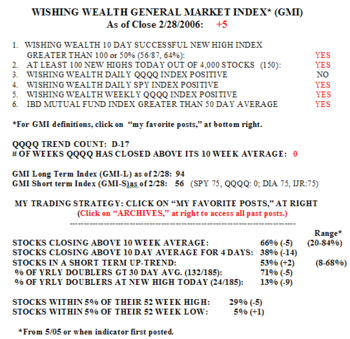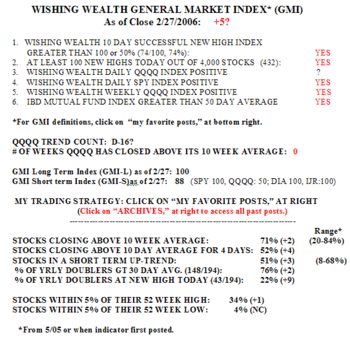The GMI was again +5, and very close to a maximum reading of +6. This is because the QQQQ came back strongly. It closed back over its 30 day average and the MACD had a bullish crossover. One more up day will turn the Daily QQQQ Index positive. The growing strength of the QQQQ is also reflected in the rebound of the short term GMI-S, to 88. The longer term GMI-L is at a maximum 100.  There were 276 new 52 week highs in my universe of 4,000 stocks and 34% of the stocks are within 5% of a 52 week high. 74% of the stocks that hit a new high ten days ago closed higher on Wednesday than they did ten days earlier. Buying stocks at new highs 2 weeks ago has therefore likely to have been profitable. 79% of the Nasdaq 100 stocks advanced on Wednesday, along with 73% of the S&P 500 stocks and 83% of the Dow 30 stocks. 55% of stocks are in a short term up trend, the most since February 3. 69% of stocks are in a longer term up trend. Wednesday was the 18th and maybe final day of the recent short term down trend in the QQQQ………
There were 276 new 52 week highs in my universe of 4,000 stocks and 34% of the stocks are within 5% of a 52 week high. 74% of the stocks that hit a new high ten days ago closed higher on Wednesday than they did ten days earlier. Buying stocks at new highs 2 weeks ago has therefore likely to have been profitable. 79% of the Nasdaq 100 stocks advanced on Wednesday, along with 73% of the S&P 500 stocks and 83% of the Dow 30 stocks. 55% of stocks are in a short term up trend, the most since February 3. 69% of stocks are in a longer term up trend. Wednesday was the 18th and maybe final day of the recent short term down trend in the QQQQ………
A number of stocks with recent quarterly earnings increases of 100% or more had large volume (at least twice their 50 day average volume) moves up today. They include: SPW, TER, ATHR, WIRE, ASEI, ASTSF, ASF, JOYG and CYBS. I own some of these. The Nasdaq 100 may be about to break out on the up side. Given that the leaders of a new rise often are among the first stocks to break out, this list may be worth watching.
Please send your comments to: silentknight@wishingwealthblog.com.

